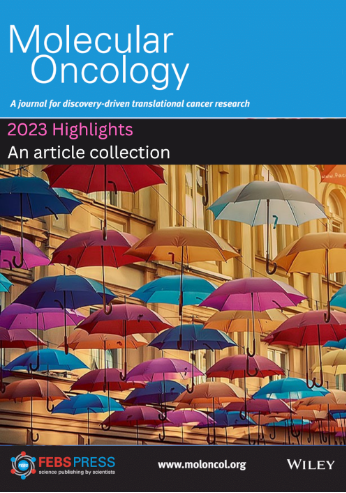结直肠癌细胞和患者外泌体的脂质组学分析揭示了潜在的生物标志物
IF 5
2区 医学
Q1 ONCOLOGY
引用次数: 21
摘要
强有力的证据表明,外泌体中脂质分子组成的差异取决于细胞类型,并对癌症的发生和发展产生影响。在这里,我们通过液相色谱-质谱(LC-MS)分析了来源于人类细胞系正常结肠粘膜(NCM460D)、结直肠癌(CRC)非转移性(HCT116)和转移性(SW620)的外泌体的脂质组学特征,以及从非转移性和转移性结直肠癌患者和健康供体的血浆中分离的外泌物。对这项详尽的脂质研究的分析强调了在细胞系中发现并在患者中得到证实的一些分子物种的变化。例如,与健康供体和对照细胞相比,原发性癌症患者和非转移性细胞的外泌体显示出磷脂酰胆碱(PC)34的普遍显著增加 : 1、磷脂酰乙醇胺(PE)36 : 2,鞘磷脂(SM)d18 : 1/16 : 0,己糖基神经酰胺(HexCer)d18 : 1/24 : 0和HexCer d18 : 1/24 : 1.有趣的是,在转移细胞系和患者中,这些相同的脂质种类减少了。此外,PE水平34 : 2,第36页 : 2和磷酸化的PE p16 : 0/20 : 4在转移性条件下与非转移性对应物相比也显著降低。与对照组相比,在转移条件下(在患者和细胞中)发现的唯一显著增加的分子种类是神经酰胺(Cer)d18 : 1/24 : 1.细胞外小泡中脂质种类的减少可能反映了转移细胞膜的功能相关变化。尽管这些潜在的生物标志物需要在更大的队列中进行验证,但它们为使用脂质生物标志物簇而不是单个分子来诊断CRC的不同阶段提供了新的见解。本文章由计算机程序翻译,如有差异,请以英文原文为准。
Lipidomic profiling of exosomes from colorectal cancer cells and patients reveals potential biomarkers
Strong evidence suggests that differences in the molecular composition of lipids in exosomes depend on the cell type and has an influence on cancer initiation and progression. Here, we analyzed by liquid chromatography–mass spectrometry (LC‐MS) the lipidomic signature of exosomes derived from the human cell lines normal colon mucosa (NCM460D), and colorectal cancer (CRC) nonmetastatic (HCT116) and metastatic (SW620), and exosomes isolated from the plasma of nonmetastatic and metastatic CRC patients and healthy donors. Analysis of this exhaustive lipid study highlighted changes in some molecular species that were found in the cell lines and confirmed in the patients. For example, exosomes from primary cancer patients and nonmetastatic cells compared with healthy donors and control cells displayed a common marked increase in phosphatidylcholine (PC) 34 : 1, phosphatidylethanolamine (PE) 36 : 2, sphingomyelin (SM) d18 : 1/16 : 0, hexosylceramide (HexCer) d18 : 1/24 : 0 and HexCer d18 : 1/24 : 1. Interestingly, these same lipids species were decreased in the metastatic cell line and patients. Further, levels of PE 34 : 2, PE 36 : 2, and phosphorylated PE p16 : 0/20 : 4 were also significantly decreased in metastatic conditions when compared to the nonmetastatic counterparts. The only molecule species found markedly increased in metastatic conditions (in both patients and cells) when compared to controls was ceramide (Cer) d18 : 1/24 : 1. These decreases in lipid species in the extracellular vesicles might reflect function‐associated changes in the metastatic cell membrane. Although these potential biomarkers need to be validated in a larger cohort, they provide new insight toward the use of clusters of lipid biomarkers rather than a single molecule for the diagnosis of different stages of CRC.
求助全文
通过发布文献求助,成功后即可免费获取论文全文。
去求助
来源期刊

Molecular Oncology
医学-肿瘤学
CiteScore
12.60
自引率
1.50%
发文量
203
审稿时长
6-12 weeks
期刊介绍:
Molecular Oncology highlights new discoveries, approaches, and technical developments, in basic, clinical and discovery-driven translational cancer research. It publishes research articles, reviews (by invitation only), and timely science policy articles.
The journal is now fully Open Access with all articles published over the past 10 years freely available.
 求助内容:
求助内容: 应助结果提醒方式:
应助结果提醒方式:


